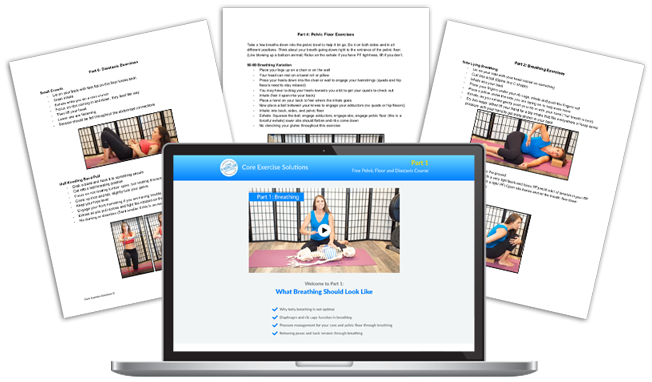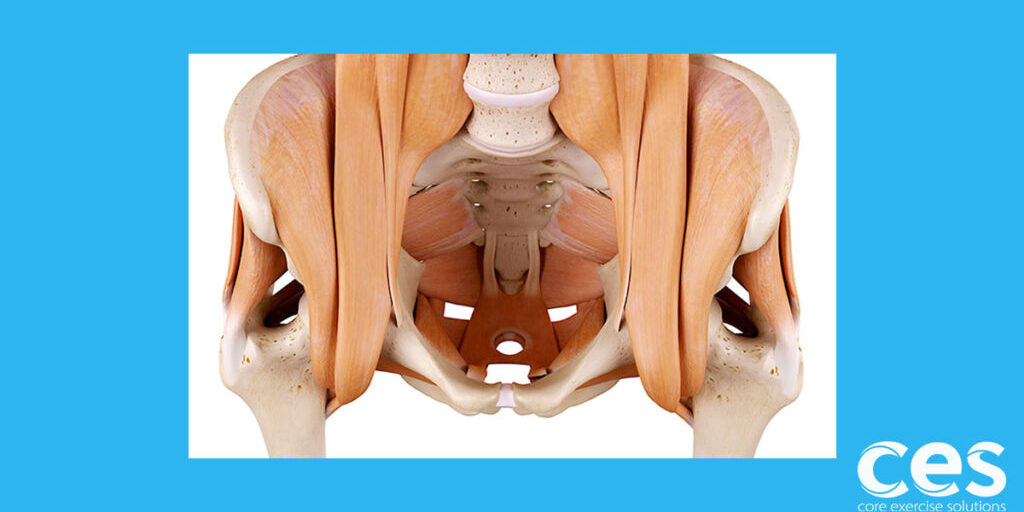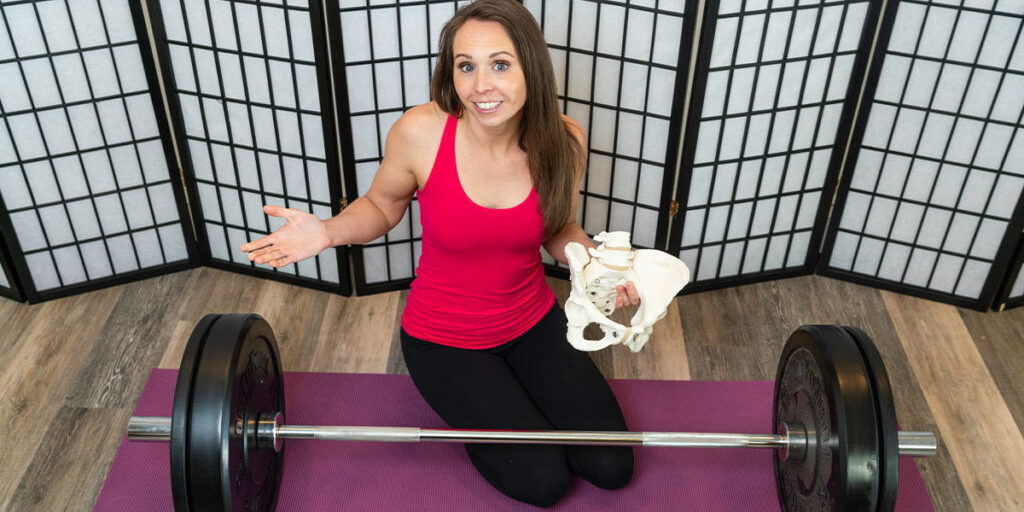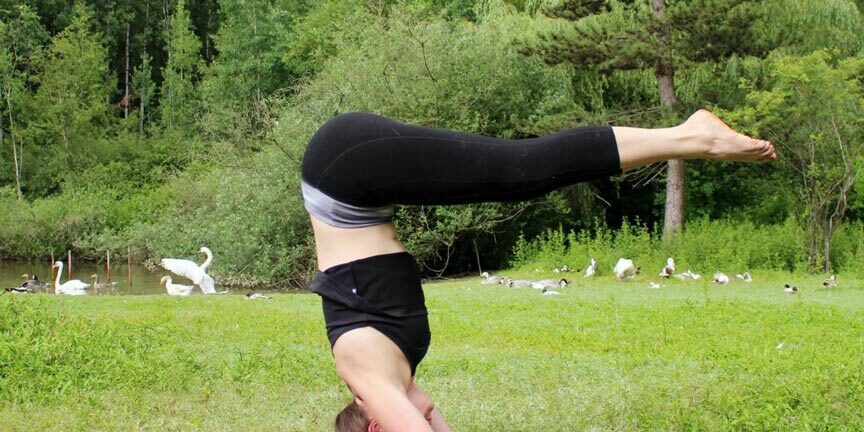Should we, as women, consider a different training schedule for different times of the month? Well, maybe! A lot will depend on your life stress level and your hormone fluctuations.
Some women don’t feel much change throughout their cycle and other women feel like they become a completely different person. With this in mind, experimenting could be a great idea!
I’ve noticed with my clients healing from diastasis and pelvic floor issues that the subtle cycle changes can affect the springiness of their tissue and they may feel like they had a setback, but really it’s just the week before their period or maybe ovulation giving them a hard time. I promise you’re not going crazy, laxity does seem to change throughout the cycle.
All the more reason to get in touch with your body’s natural rhythms. I’d like to second Adam’s advice to keep a journal and report how you feel. If you normally cut back on exercise during your period because you feel bloated and tired, try increasing gentle exercise or go for a brisk walk and see how you feel. You might be surprised at how much moving helps! If you feel all-over-the-place loose and your pelvic floor feels vulnerable during this time, be sure to cut back on exercises that increase intra-abdominal pressure (heavy lifting or impact exercise) on those particular days. It’s not all or nothing, so think submax weight instead of beast mode. Moving vs not moving is generally better for the pelvic floor as long as you’re managing pressure well.
I’d like to turn this article over to PCES student and coach Adam Willis. He’s a male coach who goes all in when it comes to helping his female clients. Not only is he learning through the Pregnancy and Postpartum Corrective Exercise Specialist Course, but he’s done extensive research to help his clients. Most male coaches working with women never take the time to learn about the differences between training women versus men. Thanks Adam, for being one of those exceptional coaches and for sharing your knowledge on hormones.
Article was written by: Adam Willis
A lot of coaching and programming time is spent managing different stressors that clients encounter on their fitness or athletic journeys so they can effectively train, recover well, and make great progress despite these obstacles.
There is, however, a highly impactful stressor that is often overlooked when it comes to women’s training— the stress caused by the menstrual cycle.
As a male coach, I didn’t speak about this subject with my female clients for years through naivety (and most likely also through immaturity).
This naivety tends to be due to:
- Not following a training program with a tendency to change lots of exercises, sets and reps each week, resulting in never noticing a decrease in training performance (as there’s nothing to compare one week of training to the next.)
- Not tracking their cycle days, where they are in their cycle, or how they feel during it so they aren’t aware of patterns occurring when compared with their training.
- Not noticing if any negative effects are experienced and when noticeable changes in training happen. If any do, they often are just chalked up as normal and something you just get on and deal with, rather than seen as an issue.
If you’re looking to maximize your training results, then having a better understanding of the potential physical, psychological and hormonal fluctuations during your cycle can be really important.
Your first port of call then is to track your cycle and other metrics that may be affected. This will allow you to see the effects on your training during the various phases of your cycle.
You want to track:
- When the first day of your menstrual bleeding occurs (start of Menstrual Cycle) and how many days it lasts.
- How much weight you can lift for key exercises during the duration of your cycle (from the start of one menstrual cycle to the beginning of the next one). This will highlight to you if your lifting strength increases or decreases in any phase in your cycle.
- Your RPE, or Rate of Perceived Exertion (how hard an exercise feels on a scale of 1-10) for your key lifts and also for any cardio, HIIT (high-intensity interval training) or finishers you perform. This will show if any cycle phase affects how you perceive your exercise exertion. Especially during the menstrual phase, a woman’s perception of pain can change.
- If possible, track your heart rate during your cardio, HIIT and finishers and even your recovery periods as well. This will highlight if you fatigue faster during these training approaches, how you recover, and if your heart rate is elevated more than normal, which can be common during the menstrual phase due to an increase in body temperature.
- Any other fluctuations you may notice during your cycle.
Once tracking brings you a greater understanding of how and when your cycle may affect you, you can potentially choose a more suitable approach for your programming structure so that it works WITH the undulations of your cycle rather than against it.
Before we delve into the programming approach, let’s break down the phases of the Menstrual Cycle and highlight a few potential issues that may occur.
Phase 1 – Menstrual Phase (Days 1-5 of the cycle)
This phase starts from the first day of menstrual bleeding and will typically last anywhere from 1-5 days.
- Potential decreases in strength due to fatigue during menstrual bleeding phase (Pallavi, Souza & Shivaprakash, 2017).
- Blood loss may affect performance physically (Pallavi, Souza & Shivaprakash, 2017)
- Higher levels of muscular fatigue experienced compared to Follicular and Luteal Phases (Julian, Hecksteden, Fullagar & Meyer, 2017; Pallavi, Souza & Shivaprakash, 2017).
- Potential increases in pain sensitivity (this may cause an increase in RPE experienced) (Hooper, Bryan & Eaton, 2011; Máximo et al., 2015).
- Some dysmenorrhea pain experienced (varies from person to person) (Máximo et al., 2015).
- Potential increases in psychological stressors (Pallavi, Souza & Shivaprakash, 2017).
Phase 2 – Follicular Phase (Day 1-14 of the cycle)
The Follicular Phase lasts from the first day of menstrual bleeding to ovulation, which is typically about 14 days. However, for the sake of this article, we’ll be categorizing the Follicular Phase as the post-menstrual period leading to ovulation.
- Potential performance increases in strength and endurance due to an increase in oestrogen and noradrenaline leading to potentially higher, more forceful muscle contractions (Pallavi, Souza & Shivaprakash, 2017).
Phase 3 – Luteal Phase (Day 15-28 of the cycle)
The Luteal Phase is the final phase of the cycle, lasting from ovulation to the start of the new cycle.
- Strength and power is rarely affected in this phase (Julian, Hecksteden, Fullagar & Meyer, 2017).
- Potential decreases in aerobic and glycolytic performance can sometimes be experienced due to increased body temperature limiting prolonged exercise capabilities (Julian, Hecksteden, Fullagar & Meyer, 2017; Pallavi, Souza & Shivaprakash, 2017).
As you can see, many potential factors to consider for maximizing your training results.
Although research on this subject is still limited and like most things is often conflicting, I feel there are 4 key physiological factors to consider based on the current evidence.
- Strength, power, and high neural demand training components doesn’t seem to experience much of a drop-off across the 3 cycle phases (Hooper, Bryan, & Eaton, 2011; Máximo, et al., 2015; Wikstrom-Frisen, Boraxbekk & Henriksson-Larsen, 2016; Julian, Hecksteden, Fullagar & Meyer, 2017; Pallavi, Souza & Shivaprakash, 2017).
Yes, the first bullet point for the Menstrual Phase does state there could be a potential drop-off in strength, but this phase is the shortest in duration ranging anywhere from 1-5 days so if it is affected the impact tends to be minimal.
* I currently have only one female client who experiences a strength drop-off and it’s only ever for 1 day. Prior to that, I have only ever had one female client who experienced a drop-off for the week.
- Aerobic and glycolytic training components can experience a drop-off in performance due to increased fatigue levels, thermoregulation issues (increased body temp) and substrate availability, with fatigue factors being most prevalent during the Menstrual Phase of the cycle (Wikstrom-Frisen, Boraxbekk & Henriksson-Larsen, 2016; Julian, Hecksteden, Fullagar & Meyer, 2017; Pallavi, Souza & Shivaprakash, 2017).
- Potential performance increases during the Follicular Phase can be experienced in strength and endurance due to an increase in oestrogen and noradrenaline leading to potentially higher, more forceful muscle contractions (Pallavi, Souza & Shivaprakash, 2017).
- The mean value of the work performed in the Follicular Phase is higher than the 2 other phases, and the Luteal Phase had a higher level of work performed than Menstrual Phase (Pallavi, Souza & Shivaprakash, 2017).
Obviously, every woman experiences a different cycle and even each individual cycles can be different. Some women experience a few of the performance-affecting issues, and others experience none.
Regardless of the level of impact a cycle has on a woman, based on the 4 physiological factors alone, smarter programming choices that work with the cycle fluctuations rather than against it can be made.
- Strength and power training doesn’t experience much drop-off (if any) across the 3 phases, so program intensity is rarely affected. This means you should be able to lift “heavy” the majority of the time and your cycle shouldn’t affect your strength too much.
If your strength is affected during the Menstrual Phase, I would utilize a weight deload approach where you would drop the weight of the lift to 90% of the previous week’s weight.
- Fatigue/tiredness can be a big limiting factor for training during your Menstrual Phase, so decreasing your overall training volume (volume is calculated as sets x reps) during this time by reducing the amount of sets you perform by 25-50% will minimise the impact and will also ensure your training doesn’t exacerbate the issue by adding more stress.
- There is a potential for training performance increases in strength and endurance during the Follicular Phase, so you can ensure you take advantage of this by making this your hardest training week. During this week you’ll be able to handle more overall training work and be most likely to be at your strongest as well, so some PRs may be up for grabs.
- The mean amount of work performed across the 3 Phases was highest in the Follicular Phase, meaning potentially more overall training and training with heavier weights can be achieved during this phase than in the Menstrual or Luteal Phase. Where possible, you want to ensure you maximize your training during this phase of your cycle.
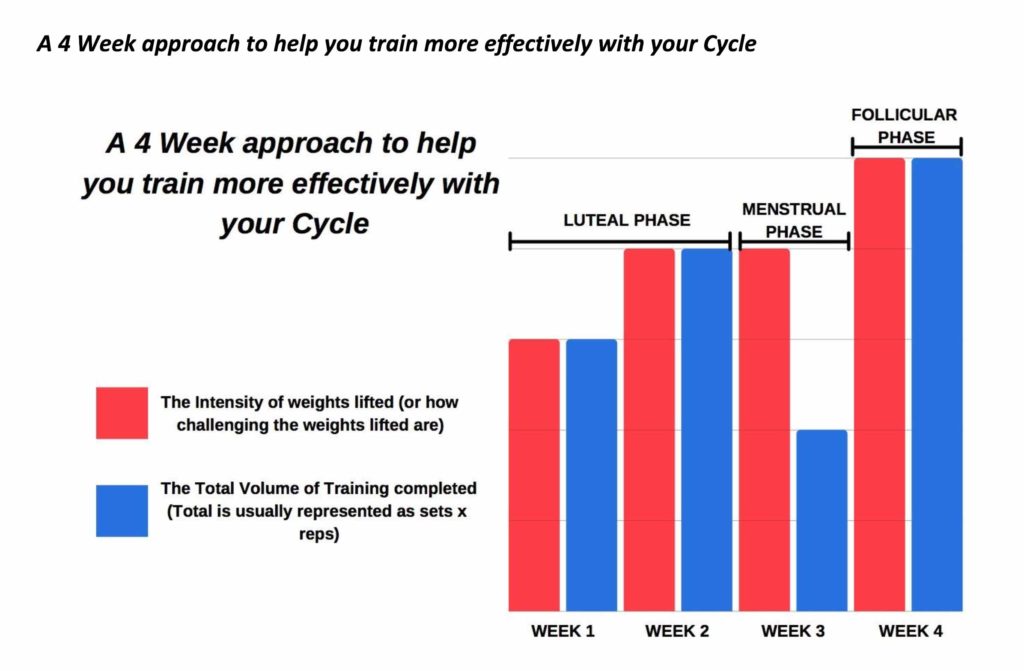
In the above graphic you’ll see that Week 1 of your program (which is almost always an introduction week where movement patterns, tempo, sets and rep schemes etc are introduced) and Week 2, which typically is a week where weights are progressed (where appropriate) from those used in Week 1, are lined up with the Luteal phase of your cycle.
I know this may seem strange to line up Weeks 3 and 4 of your Menstrual cycle with Weeks 1 and 2 of your training program, but stick with me and it’ll all make sense in a few minutes.
The reason for this is that neither volume or intensity is at its highest during the first 2 weeks of a training program, so lining these weeks up with the Luteal Phase is a great idea. Strength is rarely compromised during the Luteal Phase, and the amount of work you’re able to perform is high due to fatigue levels being managed efficiently.
Now to Weeks 3 and 4 of the program graphic. These are the crucial weeks we want to manage to accommodate the decrease in performance during the Menstrual Phase (week 3 of the program graphic) and the potential increase in training performance during the Follicular Phase (week 4 of the program example).
As I mentioned earlier, strength and power are rarely in my experience affected during the Menstrual Phase, but muscular fatigue levels often are, so reducing your training volume during this week manages this issue.
For the most part, you shouldn’t need to decrease your weights. However, if you are someone who experiences a decrease in strength and power during this phase, I would suggest reducing your weights to 90% of the previous week’s weight.
Now to Week 4. This week can potentially allow you to take advantage of the physiological, psychological and hormonal fluctuations experienced during the Follicular Phase.
Regardless of what programming you follow, you want to line the Follicular Phase up with the highest training stress week of your program. Whether that stress is created through volume, trying to hit a new PR, or an attempt to do both, this is the week where you are likely to maximize your results.
So, let’s look at what the above 4 week graphic would look like with a lower body training day example.
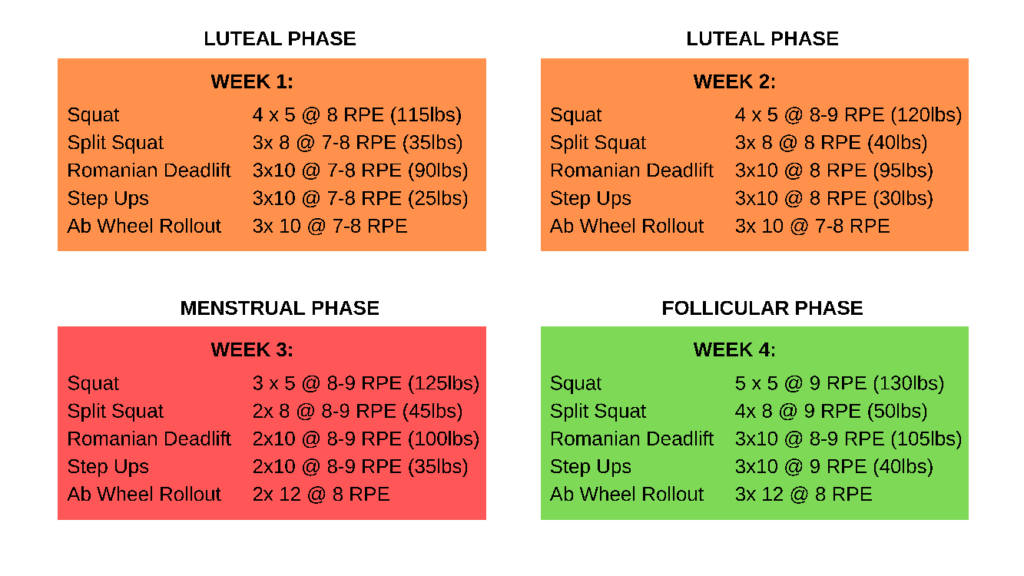
As I mentioned previously if you understand the basic physiological factors caused by your menstrual cycle you can structure almost any training program more effectively to work with your cycle fluctuations and enhance your overall results.
Just remember these 2 key programming factors
- Decrease your amount of sets to lower your volume for the week during your Menstrual Phase
- Place your hardest training week the week after your Menstrual Phase to take advantage of potential training performance increases during the Follicular Phase.
The research on training and the menstrual cycle is still very much in its infancy (Bruinvels et al., 2017) and often the methods used during the research aren’t applicable to how the majority of women train. However, what is available does help create a guideline for a more effective approach to train with the menstrual cycle rather than against it to maximize your progress and results.
Adam Willis is the host of The Empowered Body Podcast and Co-Founder & Strength & Conditioning Coach at the Lean Body Performance. He’s on a mission to educate, empower and inspire. If any of you have any questions about the Fundamentals or Training in general drop him an email at adam@leanbodyperformance.co.uk. I know he’d love to hear from you! Or check him out on Instagram at https://www.instagram.com/_adamwillis/
Click here to checkout my podcast interview with Adam on How to Take Back Control of Your Postpartum Body. He’s a great host!
References:
Bruinvels, G., Burden, R. J., McGregor, A., Ackerman, K., Dooley, M., Richards, T., & Pedlar, C. (2017). Sport, exercise and the menstrual cycle: where is the research? British Journal of Sports Medicine, 51(6), 487-488.
Hooper, A. E., Bryan, A. D., & Eaton, M. (2011). Menstrual Cycle Effects on Perceived Exertion and Pain During Exercise Among Sedentary Women. Journal of Women's Health, 20(3), 439-446.
Julian, R., Hecksteden, A., Fullagar, H. H., & Meyer, T. (2017). The effects of menstrual cycle phase on physical performance in female soccer players. Plos One, 12(3), e0173951.
Máximo, M. M., Silva, P. S., Vieira, C. S., Gonçalvez, T. M., Rosa-E-Silva, J. C., Candido-Dos-Reis, F., & Nogueira, A. A. (2015). Low-dose progestin-releasing contraceptives are associated with a higher pain threshold in healthy women. Fertility and Sterility, 104(5), 1182-1189.
Pallavi, L. C., Souza, U. J., & Shivaprakash, G. (2017). Assessment of musculoskeletal strength and levels of fatigue during different phases of menstrual cycle in young adults. Journal of Clinical and Diagnostic Research, 11(2), CC11-CC13.
Wikstrom-Frisen, L., Boraxbekk, C. J., & Henriksson-Larsen, K. (2016). Increasing training load without risking the female athlete triad: menstrual cycle based periodized training may be an answer? The Journal of sports medicine and physical fitness, 57(11), 1519-25.
Free Pelvic Floor Educational Series
Dr. Sarah Duvall, PT, DPT, CPT and the CES Team have helped thousands of women create the strength and stability needed to overcome common and not-so-common pelvic floor issues.
Join us today for this 4-part Pelvic Floor Video Series, absolutely free.
We don't spam or give your information to any third parties. View our Terms of Use and Privacy Policy.
Having trouble signing up? Click here

Working with pregnant and postpartum clients/patients?
This 6-part course offers key takeaways on breathing, pelvic floor strengthening and diastasis recovery. Sign up and start learning today!


